初中英语教案范例1
初中英语课堂教学设计案例优秀9篇
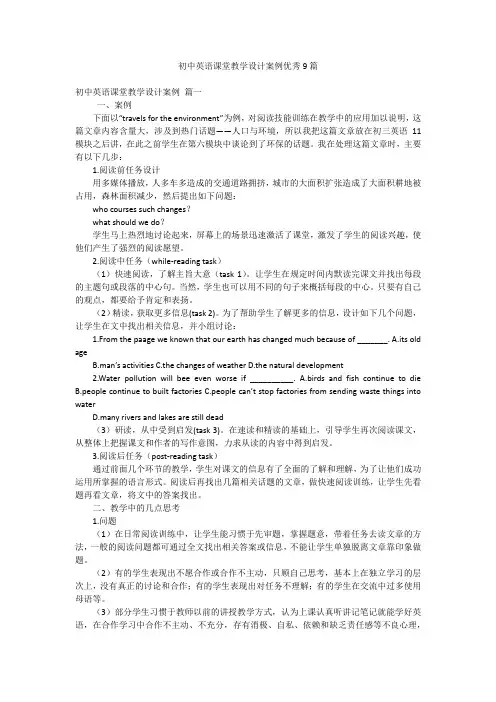
初中英语课堂教学设计案例优秀9篇初中英语课堂教学设计案例篇一一、案例下面以“travels for the environment”为例,对阅读技能训练在教学中的应用加以说明,这篇文章内容含量大,涉及到热门话题——人口与环境,所以我把这篇文章放在初三英语11模块之后讲,在此之前学生在第六模块中谈论到了环保的话题。
我在处理这篇文章时,主要有以下几步:1.阅读前任务设计用多媒体播放,人多车多造成的交通道路拥挤,城市的大面积扩张造成了大面积耕地被占用,森林面积减少,然后提出如下问题:who courses such changes?what should we do?学生马上热烈地讨论起来,屏幕上的场景迅速激活了课堂,激发了学生的阅读兴趣,使他们产生了强烈的阅读愿望。
2.阅读中任务(while-reading task)(1)快速阅读,了解主旨大意(task 1)。
让学生在规定时间内默读完课文并找出每段的主题句或段落的中心句。
当然,学生也可以用不同的句子来概括每段的中心。
只要有自己的观点,都要给予肯定和表扬。
(2)精读,获取更多信息(task 2)。
为了帮助学生了解更多的信息,设计如下几个问题,让学生在文中找出相关信息,并小组讨论:1.From the paage we known that our earth has changed much because of _______. A.its old ageB.man’s activitiesC.the changes of weatherD.the natural development2.Water pollution will bee even worse if __________. A.birds and fish continue to dieB.people continue to built factoriesC.people can’t stop factories from sending waste things into waterD.many rivers and lakes are still dead(3)研读,从中受到启发(task 3)。
初中英语教案模板(优秀8篇)
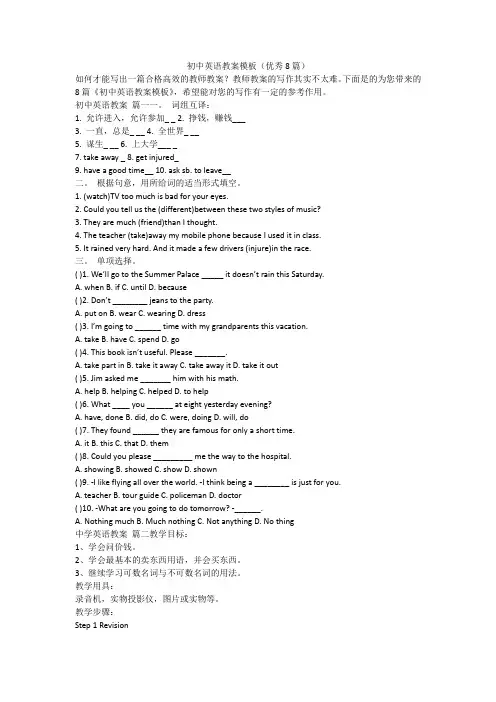
初中英语教案模板(优秀8篇)如何才能写出一篇合格高效的教师教案?教师教案的写作其实不太难。
下面是的为您带来的8篇《初中英语教案模板》,希望能对您的写作有一定的参考作用。
初中英语教案篇一一。
词组互译:1. 允许进入,允许参加_ _2. 挣钱,赚钱___3. 一直,总是_ __4. 全世界_ __5. 谋生_ __6. 上大学___ _7. take away _ 8. get injured_9. have a good time__ 10. ask sb. to leave__二。
根据句意,用所给词的适当形式填空。
1. (watch)TV too much is bad for your eyes.2. Could you tell us the (different)between these two styles of music?3. They are much (friend)than I thought.4. The teacher (take)away my mobile phone because I used it in class.5. It rained very hard. And it made a few drivers (injure)in the race.三。
单项选择。
( )1. We’ll go to the Summer Palace _____ it doesn’t rain this Saturday.A. whenB. ifC. untilD. because( )2. Don’t ________ jeans to the party.A. put onB. wearC. wearingD. dress( )3. I’m going to ______ time with my grandparents this vacation.A. takeB. haveC. spendD. go( )4. This book isn’t useful. Please _______.A. take part inB. take it awayC. take away itD. take it out( )5. Jim asked me _______ him with his math.A. helpB. helpingC. helpedD. to help( )6. What ____ you ______ at eight yesterday evening?A. have, doneB. did, doC. were, doingD. will, do( )7. They found ______ they are famous for only a short time.A. itB. thisC. thatD. them( )8. Could you please _________ me the way to the hospital.A. showingB. showedC. showD. shown( )9. -I like flying all over the world. -I think being a ________ is just for you.A. teacherB. tour guideC. policemanD. doctor( )10. -What are you going to do tomorrow? -______.A. Nothing muchB. Much nothingC. Not anythingD. No thing中学英语教案篇二教学目标:1、学会问价钱。
初中优秀英语教案范文5篇
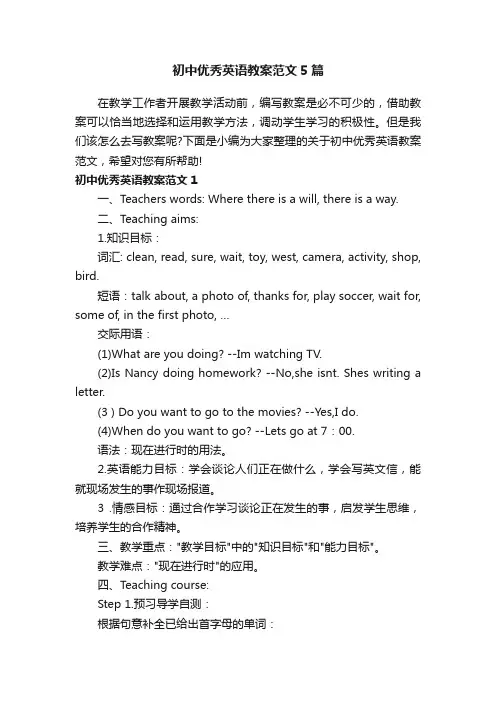
初中优秀英语教案范文5篇在教学工作者开展教学活动前,编写教案是必不可少的,借助教案可以恰当地选择和运用教学方法,调动学生学习的积极性。
但是我们该怎么去写教案呢?下面是小编为大家整理的关于初中优秀英语教案范文,希望对您有所帮助!初中优秀英语教案范文1一、Teachers words: Where there is a will, there is a way.二、Teaching aims:1.知识目标:词汇: clean, read, sure, wait, toy, west, camera, activity, shop, bird.短语:talk about, a photo of, thanks for, play soccer, wait for, some of, in the first photo, …交际用语:(1)What are you doing? --Im watching TV.(2)Is Nancy doing homework? --No,she isnt. Shes writing a letter.(3 ) Do you want to go to the movies? --Yes,I do.(4)When do you want to go? --Lets go at 7:00.语法:现在进行时的用法。
2.英语能力目标:学会谈论人们正在做什么,学会写英文信,能就现场发生的事作现场报道。
3 .情感目标:通过合作学习谈论正在发生的事,启发学生思维,培养学生的合作精神。
三、教学重点:"教学目标"中的"知识目标"和"能力目标"。
教学难点:"现在进行时"的应用。
四、Teaching course:Step 1.预习导学自测:根据句意补全已给出首字母的单词:1、My little brother is w_____ a letter.2、The students are c_____ the classroom.3、The boy is taking a photo with a c______.4、Are they w_____ for a bus over there?5、Hes r_____ a newspaper.小小翻译家:1、talk about________2、a photo of________3、wait for________4、in the first photo________5、电话交谈________6、踢足球________7、因…而感谢________ 8、许多图书馆_______Step2情境导入Look at the pictures in P25 1a and write sentencesNow its 6:00 pm. What are they doing?In picture A. She is talking on the phone.In picture B. ________________________In picture C. ________________________In picture D. ________________________In picture E. ________________________In picture F. ________________________Step3自主探究1.以上练习的句子是什么时态?_______________________________.2.该时态的结构是_________________________________________.3.现在分词的构成规则A、一般直接在动词后加______,如reading,watch_____, talk____ .B、以字母不发音的e结尾的____________,如writing,come_______, make ____ .C、一个元音字母加一个辅音字母结尾且末尾只有一个辅音字母的重读闭音节词要_____________________ 。
初中英语教案(15篇)_1
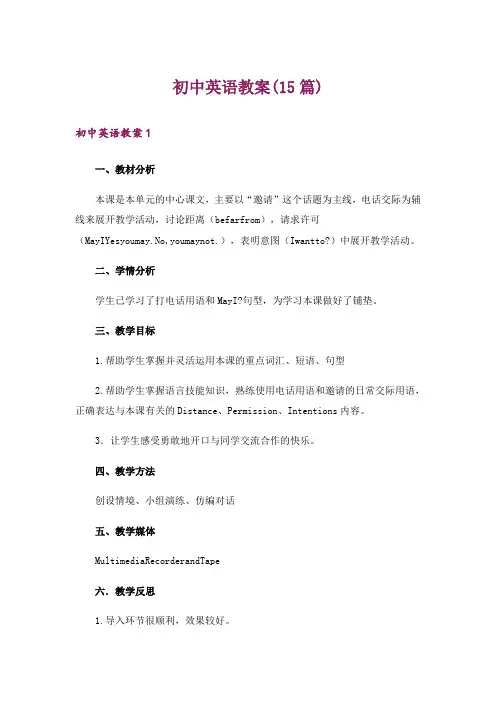
初中英语教案(15篇)初中英语教案1一、教材分析本课是本单元的中心课文,主要以“邀请”这个话题为主线,电话交际为辅线来展开教学活动,讨论距离(befarfrom),请求许可(MayIYesyoumay.No,youmaynot.),表明意图(Iwantto?)中展开教学活动。
二、学情分析学生已学习了打电话用语和MayI?句型,为学习本课做好了铺垫。
三、教学目标1.帮助学生掌握并灵活运用本课的重点词汇、短语、句型2.帮助学生掌握语言技能知识,熟练使用电话用语和邀请的日常交际用语,正确表达与本课有关的Distance、Permission、Intentions内容。
3.让学生感受勇敢地开口与同学交流合作的快乐。
四、教学方法创设情境、小组演练、仿编对话五、教学媒体MultimediaRecorderandTape六.教学反思1.导入环节很顺利,效果较好。
2.创设情境让学生仿编演小对话环节较成功,让学生感觉到说英语并非想象的那么困难。
3.学生小组互助自学环节不太理想,部分学生胆怯,主动性不强,应加强鼓励,设法调动全体学生的学习兴趣,帮助他们增强自信。
4.前面语言训练环节用时间较多,使后面巩固知识的练习时间不足,只能让学生课后完成。
今后应尽量控制好各个教学环节的时间分配。
初中英语教案2一、教学目标在本节课结束时,学生将能够:用正确的语言谈论如何学习;用by+ doing 的结构描述自己的学习方式;能够就英语学习与他人进行简单的口语交流。
知识与能力:通过本课学习,用目标语言谈论如何学习英语,就英语问题进行简单的沟通,同时在与他人的合作与交流中帮助他人,树立自己学习的信心。
过程与方法:采用小组合作探究、听力练习、对话练习、猜测问题和角色互换的学习策略,利用视频、PPT和制作课件等来展开课堂教学环节等,进行“询问和谈论学习方法、解决困惑”的课堂教学和练习。
本单元的教学法建议:短语教学——采取情景引入展开启发式的教学方式,让学生在思考中输出自己的语言,并在句型中学会运用;语音教学——让学生进行听对话并跟读听力材料;口语教学——采取对话练习和角色互换对学生进行教学;听力教学——采取听音配对、听音打钩和听音对应等的方式进行听力教学和听力技巧指导;口语教学——通过创设情境让学生进行对话练习和角色互换活动,来进行语言的输出。
优秀初中英语教学教案5篇
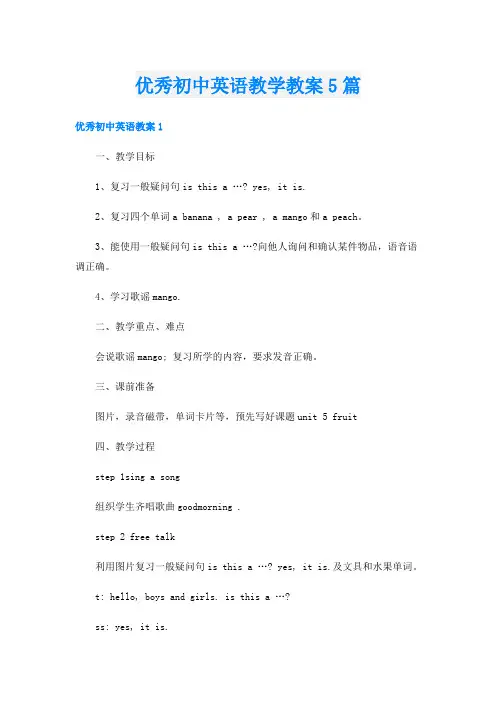
优秀初中英语教学教案5篇优秀初中英语教案1一、教学目标1、复习一般疑问句is this a …? yes, it is.2、复习四个单词a banana , a pear , a mango和a peach。
3、能使用一般疑问句is this a …?向他人询问和确认某件物品,语音语调正确。
4、学习歌谣mango.二、教学重点、难点会说歌谣mango; 复习所学的内容,要求发音正确。
三、课前准备图片,录音磁带,单词卡片等,预先写好课题unit 5 fruit四、教学过程step 1sing a song组织学生齐唱歌曲goodmorning .step 2 free talk利用图片复习一般疑问句is this a …? yes, it is.及文具和水果单词。
t: hello, boys and girls. is this a …?ss: yes, it is.step 3 play a game这是一个“摸摸猜猜”游戏。
教师准备好一个不透明的包,放入需要的物品。
1、讲解游戏的做法。
2、带领全班学生做游戏。
教师先做示范。
t: boys and girls, let’s play a game.t: look! this is my bag. there are many fruit in it, but you can’t see it. you can touch and guess. let me try first.(教师将手伸入包里摸一下水果,想一下,然后闭上眼睛推测is this a ..?一边说一边将水果拿出来给学生看,等到学生给予应答后才睁开眼睛看自己说的对不对。
)优秀初中英语教案2一、教学目标:1. 语言知识目标:1) 能掌握以下单词:allow, wrong, guess, deal, work out能掌握以下句型:①—What’s wrong?—I’m really tried because I studied until midnight last night.② You could give him a ticket to a ball game.③ I think you should ask your parents for some money.④ Why don’t you talk to him about it?2) 能了解以下语法:(1)能够运用所学知识谈论问题和困难、提出建议并做出选择;(2)能根据对方所提出的问题,给出一些合理的建议。
初中七年级英语教案范文三篇
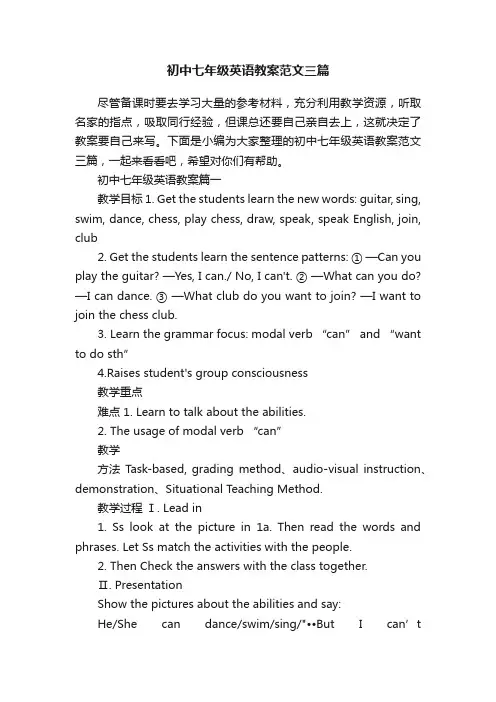
初中七年级英语教案范文三篇尽管备课时要去学习大量的参考材料,充分利用教学资源,听取名家的指点,吸取同行经验,但课总还要自己亲自去上,这就决定了教案要自己来写。
下面是小编为大家整理的初中七年级英语教案范文三篇,一起来看看吧,希望对你们有帮助。
初中七年级英语教案篇一教学目标 1. Get the students learn the new words: guitar, sing, swim, dance, chess, play chess, draw, speak, speak English, join, club2. Get the students learn the sentence patterns: ① —Can you play the guitar? —Yes, I can./ No, I can't. ② —What can you do? —I ca n dance. ③ —What club do you want to join? —I want to join the chess club.3. Learn the grammar focus: modal verb “can” and “want to do sth”4.Raises student's group consciousness教学重点难点 1. Learn to talk about the abilities.2. The usage of modal verb “can”教学方法Task-based, grading method、audio-visual instruction、demonstration、Situational Teaching Method.教学过程Ⅰ. Lead in1. Ss look at the picture in 1a. Then read the words and phrases. Let Ss match the activities with the people.2. Then Check the answers with the class together.Ⅱ. PresentationShow the pictures about the abilities and say:He/She can dance/swim/sing/"••But I can’tdance/swim/sing/...Ⅲ. Game (What can I do?)T: Tell your partners what you can do. For example:I can play the guitar. I can sing and dance.Ss work in groups. The let some Ss talk to their classmates in front of the class.Ⅳ. Listening1. T: Now let’s listen to the tape, find out the right conversation, and number them 1-3.2. Check the answers: (3, 2, 1 )Ⅴ. Pair work1. Ask the Ss to practice the conversations in 1b with a partner. Then make their own conversations. Ⅵ. Listening1. Work on 2a;T: Now, look at the pictures on P2, listen to the four conversations. Just listen.(Play the recording for the first time, students only listen carefully.)Then, listen to the recording again, and circle the clubs you hear.Check the answers with the class.2. Work on 2b;3. Check the answers with the Ss.Ⅶ. Pair work1. Look at 2b and talk about what the people can do and the clubs they want to join.T: What club does Lisa want to join?S1: She wants to join the chess club.T: Can she play chess?S1: No, she can't.2. Ss work in pairs to practice asking and answer about Lisa, Bob and Mary.3. Ask some pairs to act out their conversations.Ⅷ.Homework:1. Remember the new words and expressions after class.2. Recite the conversation after class.3. Write English names as many as possible in the exercises book.Ⅸ.Blackboard design Section A 1 (1a-2d)Drills:1. —Can you sing? —Yes, I can./No, I can't.2. 2b: 1. chess, chess 2. English; English3. sing, dance, music4. ① What club does Bob join?② What club does Jane join?5. want to do sthThey want to have some rice and vegetables.初中七年级英语教案篇二第一单元备课教案一、语言知识与技能1.根据读音规则和音标拼读单词。
2024年初中英语教学案例(优秀8篇)
2024年初中英语教学案例(优秀8篇)初中英语教学案例篇一一、关注学生情感,创造民主、和谐的教学气氛。
学生只有对自己、对英语及其文化有积极的情态,才能保持英语学习的动力并取得成绩,刻板的情态,不仅会影响英语学习的效果,还会影响其它发展,情态是学好英语的重要因素,因此我努力创造宽松民主、和谐的教学空间,做到:1、尊重每个学生,积极鼓励他们在学习中的尝试,保护他们的自尊心和积极性。
2、把英语教学与情态有机地结合起来,创造各种合作学习的活动,促进学生互相学习,互相帮助,体验成就感,发展合作精神。
3、关注学习有困难的或性格内向的学习,尽可能地为他们创造语言的机会。
4、建立融洽、民主的师生交流渠道,经常和学生一起反思学习过程和学习效果,互相鼓励和帮助,做到教学相关。
二、面向全体学生,为学生全面发展和终身发展奠定基础。
1、创设各种情景,鼓励学生大胆地使用英语,对他们在学习过程中的失误和错误采取宽容的态度。
2、为学生提供自主学习和直接交流的机会,以及充分表现和自我发展的一个空间。
3、鼓励学生通过体验、实践、合作、探索等方式,发展听、说、读、写的综合能力。
4、创造条件让学生能够探究他们自己的一些问题,并自主解决问题。
三、加强对学生学习策略的指导,让他们在学习和适用的过程中逐步学会如何学习做到:1、积极创造条件,让学生参与到阶段性学习目标,以及实现目标的方法。
2、引导学生结合语境,采用推测、查阅和协调的方法进行学习。
3、引导学生在学习过程中,进行自我评价,并根据需要调整自己的学习目标和学习策略。
四、对学生进行有效的评价。
评价可以使学生认识自我,树立自信,有助于反思及调整自己的学习过程,评价或采用测验及非测验形式,平时重视形成性评价,对学生回答学习过程中的表现所改进的诚绩,及反映的情感、态度、策略某方面进行及时的评价,如有口头评价、等级评价、学生之间互相评价等方法,充分发觉学生的进步,鼓励学生自我反思,自我提高,测验以学生综合运用能力为目标,侧重于学生理解和获取信息,能力减少客观题,增加主观题,通过评价学生学会分析自己的成绩和不足,明确努力方向。
最新初中英语教案英文版(优秀四篇)
最新初中英语教案英文版(优秀四篇)初中英语教案英文版篇一how many desks are there? there are thirty-two. a book ten bookshow many接可数名词复数形式的.句型;数字1-10的拼写多媒体、录音机课时 1s1: how many …are there-s2: there are…ng.g-up1)learn the numbers 1-10. then listen and match.2) students listen and say the numbers.3) listen and say:t: what’re these/those?s: they’re eyes..t: how many desks are there?s: there are 32.work in pairs. ask and say.s1: what’re these?1) write the numbers.2) look at the pictures and write the phrases.derkwork book.个人修改初中英语教案英文版篇二starter module3 unit1 课型 listeningandspeaking学习询问颜色句型what colour are …? they are red. how do you spell “red”? r-e-d.颜色词汇的拼写记忆多媒体、录音机课时 1ng.g-up1)look and learn theword:apple,banana,flower,tree,bird,cat2) look at the pictures and the colour words.3) listen and say:t: what colour are they?t: how do you spell “red”?s: r-e-d..work in pairs. ask and say.s1: what colour are they?s2: they’re….s1: how do you spell it?s2: …se1) read and match.2) look at the pictures and write the sentences.derkwork book.初中英语教案英文版篇三sectiona 1a-2d一、教学目的〔一〕知识与技能:1. 学习并掌握1a-2d的单词和短语(1) rainstorm, alarm, begin ,heavily ,suddenly, strange;(2)go off, pick up, take a shower, make sure;2. 掌握并运用句型(1)what were you doing yesterday at the time of the rainstorm?(2)when you called, i was having a shower.(3)so while you were sleeping, i called jenny and she helped me.(4)what were you doing when the rainstorm came?3.掌握过去进展时态的构造和功能,学会使用when和while从句。
初中英语公开课教案【优秀5篇】
初中英语公开课教案【优秀5篇】初中英语教案设计篇一Step 1. Lead-in (2min)T: Good afternoon, boys and girls. Who’s on duty today? Ss: …T: Is everyone here? I’m glad to hear that. Now, are you ready for our class? Ss: …T: Ok, class begins. We have learned some words about the kinds of movies last time. Who wants to tell me some of them?S: comedy, triller, cartoon, action movie, science fiction, love story, documentary.T: And a special kind of art, it’s our national opera, do you remember it?T: Yes, it’s Beijing Opera, very good. I think you must study very hard after class.Step2. 2.1 Pictures show (1 min)T:Now, please look at the pictures and tell me what kind of movies they belong to? The first group. Ss:…T: Ok, so clever your boys and girls.2.2 words writting (2min)T: Please look at the nouns on the blackboard; we know all of them are in singular form. Now I’d like to choose some of you write the plural form of each words on blackboard. ……other people can write themdown on your paper. (comedies, documentaries, thrillers, cartoons, action movies)T: let’s check the answer, is it right? Ss: …。
七年级英语教学设计详细教案(精选7篇)
七年级英语教学设计详细教案(精选7篇)初一英语教案篇一【课题】Unit1 My name’s Gina.【学习目标】知识与能力:1、掌握并规范字母Ii-Rr.2、识记本单元词汇:what, this, in, English, a, an, map, orange, jacket, key, quilt, pen, ruler, spell, please, etc.过程与方法:学会从对话中获取对方的相关信息。
情感态度与价值观:使学生学会如何礼貌的与他人交往。
【学习重难点】:熟练掌握本单元词汇及语言结构。
一、自主预习【预习任务】:任务一:写出下列汉语的英语形式。
名字xx遇见xx问题,难题xx 回答,答案xx第一的x 最后的xx任务二:写出下列单词的汉语意思。
1、my2、clock3、nice4、what5、your6、hello7、I8、you9、his10、her11、name12、are一三、is【预习诊断】:1、选择题:(1)Kate has lost(丢失) _________key、_________asked _________for help、A、her ,he, IB、his, he ,meC、his, she, ID、her, she, me(2)_________plus(加) seven is thirteen?A、FiveB、SixC、EightD、Nine(3)_________is her name?A、whoB、what C where D、How2、写出下列英语形式。
(1):电话号码?_________(2):早晨好_________(3):下午好_________3、写出下列词的英语意思:1)、早晨_________2)、下午_________3)、晚上_________4)、谢谢_________5)、名字_________6)、好的_________or_________【预习反思】:你还有什么问题吗?(Do you have any problems?)二、课中实施Step1 交流展示Step2 精讲点拨:What’s your name?你叫什么名字?句中的your可根据问对象换成his、her等物主代词。
- 1、下载文档前请自行甄别文档内容的完整性,平台不提供额外的编辑、内容补充、找答案等附加服务。
- 2、"仅部分预览"的文档,不可在线预览部分如存在完整性等问题,可反馈申请退款(可完整预览的文档不适用该条件!)。
- 3、如文档侵犯您的权益,请联系客服反馈,我们会尽快为您处理(人工客服工作时间:9:00-18:30)。
初中英语教师面试——初中英语教案范例Unit 6 How do you get to school?一、教材分析本单元的中心话题是“Transportation”,围绕“How do you get to school”,“How long does it take?”,“How far is it?”层层展开,并采用“任务型语言教学途径”,编排了一系列凸现“交际功能(Talk about how to get to school)”运用的听说读写综合语言活动,让学生学会谈论如何到达某个地方,距离有多远,要花多长时间等等。
这些活动紧贴学生的生活实际,极具真实性,从而使学生的个人经历成为课堂学习的有效图式,有助于学生对所获取的声音和文字英语信息的理解;有助于调动他们用英语表达自己的经验和感受兴趣和热情;有助于促进他们语言功能的运用;有助于提高他们为应用而主动学习和掌握语言知识(词汇和语法结构等)的兴趣。
在教材编排上,Section A是基础,是底线,是学生必须掌握的目标语言;而Section B是Section A的扩展和引申,通过任务型听力来讨论交通工具及方式的最佳组合方式,并通过任务型阅读帮助学生了解不同国家学生上学的交通工具及方式的异同。
二、教学目标1.语言目标词汇:subway, take the subway, train, minute, how far, quick, leave for, half, past, bus station, bus ride, stop, bust stop, north, school bus, by boat, must, car, ill, worry句式:How do you get to school? I ride my bike.How long does it take? It takes ten minutes.How far is it from your home to school? It’s about 10 kilometers.2.能力目标(1) 能够谈论如何到达目的地。
(2) 能够谈论自己的日常生活。
(3)能够有效地获取信息和处理信息。
3.情感目标(1) 学会关注生命与安全;培养时间观念,学会珍惜时间。
(2) 了解朋友及家人的生活。
4.跨学科学习(1) 社会实践:学习距离、交通方式的表达。
(2) 个性培养:学会合理安排自己的生活,培养时间观念,学会珍惜时间。
(3) 跨文化研究:了解不同国家、不同地区学生上学的交通工具及方式的异同。
三、教学重、难点通过语言目标的学习,学会谈论如何到达目的地,如何表达距离的远近,如何表达到某地花多长时间,并在生活实际中正确运用所学语言。
四、教法与学法1. 采用情境法、交际法和“任务型”教学途径,使“英语学习任务化,学习活动生活化”,通过设置多样化的任务,巧妙注意任务的序列性,让学生在教学活动中参与和完成真实的生活任务,从而培养学生运用英语的能力,(用英语做事的能力)。
在教学过程中,坚持“以人为本”,关注学生的情感,关注学生的发展,把说的机会留给学生,把思考的时间还给学生,把做的权利交给学生。
2. 充分发挥多媒体辅助教学的优势,集图片、声音、动画于一体,使课堂教学更为形象,更为直观,更为生动,学生更有兴趣,印象也会更深。
3. 采用小组合作的学习方式,让学生学会交流,学会分享,学会合作,并有效地避免班额过大、不同学生之间知识水平和智力发展参差不齐,同时师生之间、学生之间的交际得不到充分发挥等问题。
五、教学程序设计核心任务及任务链根据本单元学习有关交通方面的内容,设计核心任务为“2000元欢乐假日行”,形成如下任务链:了解周围的人是如何到校、如何上班的——选择适合自己的交通工具或交通工具组合方式——威海一日游——说明不同国家、不同地区学生上学的交通工具及方式的异同——2000元欢乐假日行——比较交通工具的特点与优劣势——向政府提出合理建议,改善交通环境。
第一课时第一课时以听说为主,教学目标为:1.学会谈论如何到达某地,学会谈论自己、朋友、家人如何上学、工作;2.熟练掌握到达某地要花多长时间的表达,学会谈论自己的生活;3.学会合作,了解朋友和家人的生活;4.学会关注生命与安全;培养时间观念,学会珍惜时间。
本课的核心任务是Know more about your friends,并通过How do you get to school? How does he/she get to school? How long does it take? 三个小任务组成的任务链完成任务前的准备,课堂流程如下所示:Pre-class Activities拓宽视野,实现英语学习的生活化。
②③I think it’④⑤Can you see the girl in pink? What is she doing? Guess, where is she going?⑥Where is the girl with short blond hair? Can you find something strange? Why is she sitting in a wheelchair? What can we do for her?⑦What does “TERMINAL” mean?⑧How many kinds of transportation can you see in the picture?显然,读图的目的并非仅仅是导入课堂教学,更重要的是巧妙地运用课本所提供的课程资源,尽可能多地为学生提供“说英语”的机会,帮助他们逐步养成英语思维习惯。
2.通过小组合作的学习方式,交流彼此所收集的信息,实现资源共享,并通过讨论小组命名和小组竞赛两个小活动来帮助学生进一步熟悉目标词汇。
3.最后选用节奏活泼、边说边做的Chant,(内容如下)Go, go, let’ go!Ride, ride, ride my bike.Take, take, take the bus.Take, take, take the subway.…使学生在不知不觉中强化识记了有关交通工具的词汇和词块,而且也是对其后进行的Lucky 52游戏作了一次简单热身。
Task 1: How do you get to school?教师首先借助多媒体课件呈现本课的目标句型How do you get to school?,同时利用图片使学生掌握ride a bike, take the bus, take the train, take a plane, take a car等词块,并学会对目标句型做出正确应答,然后1how they get to school.How does the girl get to school?How do the boy and the girl get to school?…引导学生有针对性地第二次读图,然后完成1a的书写训练。
2.听前对录音材料进行简要的背景介绍:This time you will listen to a conversation. Two people are talking about how some students get to school. 使学生对所听内容有所预知,有所了解,从而降低了学生听的难度,使学生轻轻松松地完成任务型听力1b。
3.听力任务完成后,用大屏幕呈现完整的听力材料,让学生反复跟读录音,语音、语调、句型熟练后,改成两人一组看图自由对话。
4.最后采用学生喜闻乐见的“Lucky 52”的游戏方式,将全班分为A, B, C三组进行活动:A组面向大屏幕,并试着用动作表演屏幕所显示的交通工具,背对屏幕的C组回答B组所提问题How does he/she get to school?,也可以用Does he/she take the subway/take the bus?进行猜测,在规定时间内未能完成的小组将有一位本组成员被淘汰,最后人数多者胜出。
这个活动使学生的积极性瞬间被调动,那种一猜再猜而又未猜中,想得到真实答案的欲望也更加强烈,在竞猜中习得了前两个任务所学习的目标语言。
Task 3: How long does it take?Say: D ifferent students get to school in different ways, but you must be on time for school. You must pay close attention to time.这样适时地对学生进行了情感教育,培养了学生的时间观念,也为后部分的学习作了成功导入。
1.借助直观教具闹钟,并用手指拨动指针行走来呈现句型“How long does it take?”,并训练时间的表达,更具直观性和生活性。
2.听力无疑是学生的“老大难”,在随后进行的2a 和2b 的听力训练前,首先引导学生通过谈论图片来预测所听问题,有效地降低听力难度。
例如:在完成2a 前,引导学生用How do you get to school?进行Pair Work ,而在2b 前,用How long does it take? 来进行看图说话。
3.完成2a 和2b 后,将听力材料完整地呈现,让学生两人一组跟读、朗读到上口为止。
4.将听力材料重新设置成听力填空(如下所示)①Listen again. Fill in the blanks.by bike. by bus. by subway. by train. by ship. by plane. on foot.five minutes.ten minutes.How long does it take? It takes thirty minutes.forty minutes.two hours.然后以When do we use these sentences?来帮助学生进一步明确所学语言结构的语用。
Task 4: Know more about your friends这是一个综合性的任务,其设计以学生的生活经验和兴趣为出发点,分为Make a survey 和Make a report 两个环节:1. Make a survey2. Make a reportMake a report according to your chart.Example: Lucy takes the bus to school. It takes her ten minutes通过这两个活动,让学生进一步了解周围朋友的生活,使学生通过做事,通过思考,通过合作来体验目标语言,体验学的过程和快乐,在“用”中发展思维能力和各种语言应用能力。
